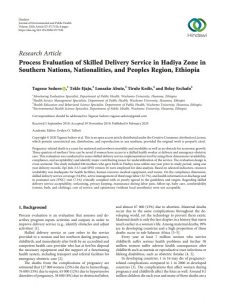
Pregnancy-related death is a cause for maternal and newborn mortality and morbidity as well as an obstacle for economic growth. Three-quarters of mothers’ lives can be saved if women have access to a skilled health worker at delivery and emergency obstetric care.
This evaluation was conducted to assess skilled delivery service implementation level by using three dimensions (availability, compliance, and acceptability) and identify major contributing issues for underutilization of the service. The evaluation design is cross-sectional. The study included 846 mothers who gave birth in Hadiya zone within one year prior to study period, using one year delivery records. Epi Info 3.5.3 and SPSS version 16 were employed for data analysis.
Based on selected indicators, resource availability was inadequate for health facilities, human resource medical equipment, and rooms. On the compliance dimension, skilled delivery service coverage (34.8%), active management of third stage labor (32.7%), and health information at discharge and in postnatal care (PNC) visit (7.1%) critically complied with or poorly agreed to the guidelines and targets.
Regarding skilled delivery service acceptability, welcoming, privacy keeping, reassurance during labor pain, follow-up, baby care, comfortability (rooms, beds, and clothing), cost of service, and episiotomy (without local anesthesia) were not acceptable.